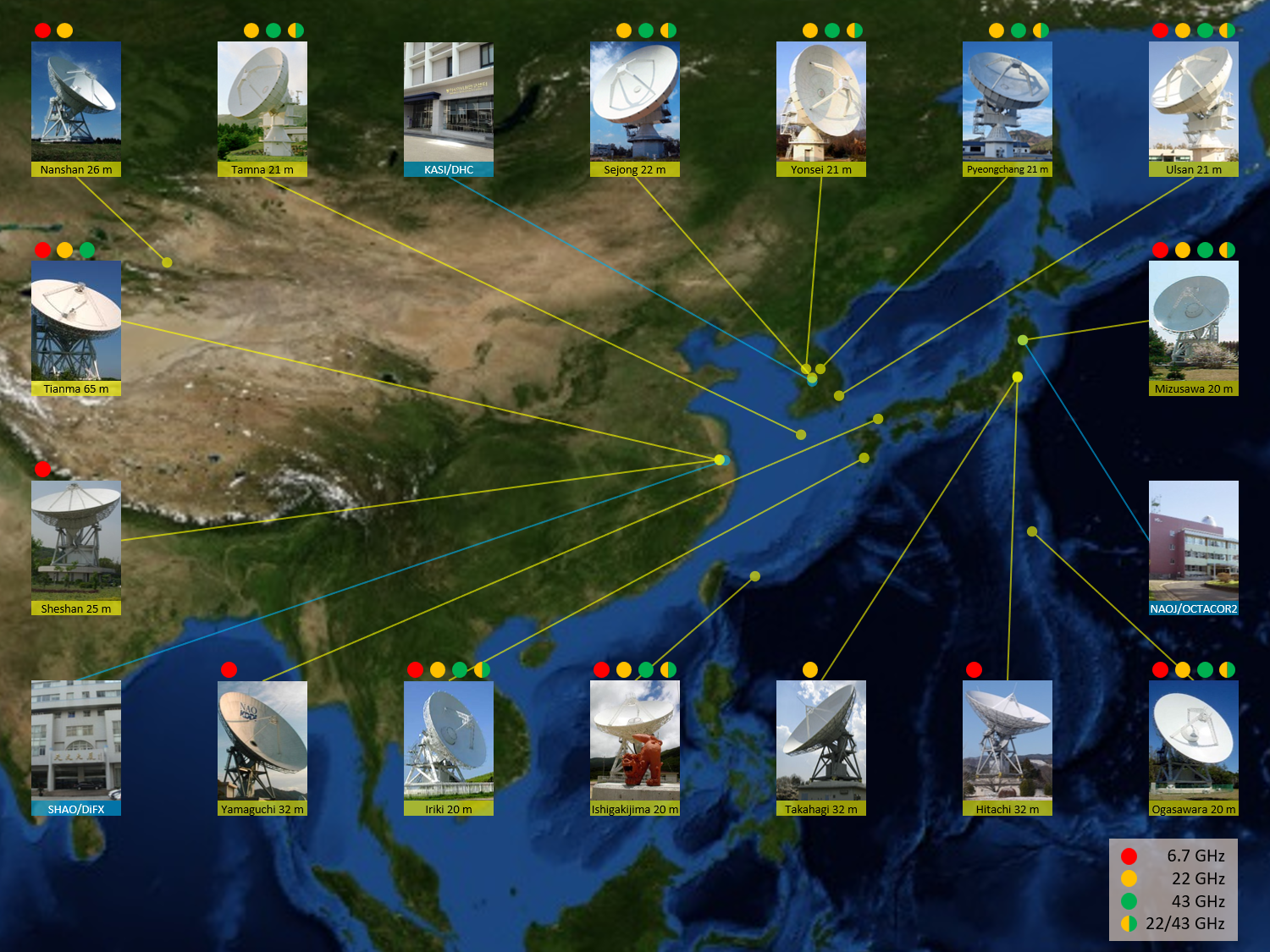About EAVN(East Asia VLBI Network)
The East Asia VLBI Network consists of radio telescopes in China, Japan and Korea. An Operation of EAVN started from 2010, however the current EAVN is still a performance testing phase. The EAVN consortium member and related astronomer have a meeting and discuss about EAVN every year.
Now there are 4 stations in China, 12 stations in Japan and 3 stations in Korea, therefore the EAVN consists of 19 stations. The performance of each telescope (e.g. diameter and receivers) has variation, the EAVN is quite unique VLBI network in the world. Main observing wavelength is a centimeter which emits from star forming region, evolved star, X-ray binary and active galactic nuclei(AGNs).

The EAVN can carry out various sciences. For example, the EAVN can reveal a rotation and infall of massive protostellar disk in the star forming region, a dynamics and origin of outflow from the protostar, kinematics of gas around evolved star, jets from X-ray binary or micro-quasar and kinematics of jets from AGNs.
Because new radio telescopes are constructing now in the east asia, the performance of EAVN will become better, the future EAVN will be able to discover a new phenomena and science. The EAVN astronomers discuss about a vision of future EAVN.
About Korean VLBI Network
The Krean VLBI Network consists of 3 stations which have same performance, that is the KVN is a VLBI array. The antenna of KVN has very unique receiver system which can observe four different frequencies simultaneously.
Although the baseline length of KVN is short less than 500 km, their receiver system is quite unique. The KVN receiver system has four different frequencies (22, 43, 86, 129 GHz) and these frequencies can be observed simultaneously. Any VLBI telescopes in the world do not have such a unique system. Moreover because a recent interests of VLBI development/experiment/science is mm-VLBI, the KVN will lead the mm-VLBI studies in the world. Moreover, the short baseline VLBI can detect object with extended structure, therefore the KVN provides us new sciences.
see details in Korean VLBI Network web site
About Japanese VLBI Network
Japanese VLBI network is a collabration of 4 institutes and 7 universities in Japan and now there are 12 radio telescopes from north to southern island in Japan. The VERA (VLBI Exploration of Radio Astrometry) VLBI array consist of 4 stations which have special instruments for VLBI astrometry. Because the radio telescopes in JVN have also their own project, the JVN carries out several observations in year after negotiating their opeartion schedules.
The radio telesopes of JVN have various performance, for example, the diameter of main dish is 11 to 64 meters. Half of them have a diameter of over 30 m, especially five of six big main dish telescopes are located within a diameter of ~200 km that is quite rare VLBI network in the world. The VERA telecope has also unique instruments which are specialized for the VLBI astrometry, that is the phase referencing VLBI. Other radio telescopes of JVN have also unique own project.
The science by JVN is various fields. The VERA measured annual parallax towards distant star forming regions and evolved stars in the Milky Way and the VERA will reveal a true structure and dynamics of the Milky Way. On the other hand, the JVN detected rotation/infall motion of protostellar disk around massive star and also very interested outflows from the protostars. The flux variation of jets from AGNs was also detected by JVN/VERA, their longer monitering observation showed us very interesting results.
The KVN and Japanese astronomers also developed a new and powerful correlator which is called KJCC (Korea-Japan Joint VLBI Correlator). The KJCC will be main correlator of the EAVN.
see details in Japanese VLBI Network web site
About Chinese VLBI Network
The Chinese VLBI Network consists of 4 stations. The oldest radio telescope is Shanghai 25m telescope which was constructed at 1987 and then started international VLBI observation. At 1993, another radio telescope was constructed in Urumqi and then the Shanghai and Urumqi station is a member of European VLBI Network (EVN). At 2006, Chinese astronomers constructed a new and big dish radio telescope near Beijing (a diameter of 50 m) and at Kunming (40 m). In the present, the CVN mainly operates for determination of trajectory of Chinese lunar satellite "Chang'e", however the astronomical VLBI observation has already started. Because there are plans to construct a new and bigger radio telescopes in China, the CVN will be a important VLBI network in the future.
The Shanghai and Urumqi station is a member of European VLBI Network (EVN) and both telescope play a role as longest baseline station. Other CVN stations, Beijing and Kunming, have not been a member of EVN yet, however these telescopes performed EVN test observation. Although the main purpose of CVN is an operation of the Chinese lunar satellite "Chang'e", the CVN also starts to perform astronomical observation. The CVN is important for longer baseline of EAVN, especially Urumqi and Kunming station.
Because now there are some plans to construct huge radio telescopes in China, for example Shanghai new 65 m telescope, higher sensitivity VLBI observation will be able to perform by such a huge telescope in near future.
see details in Shanghai Astronomical Observatory (SHAO)